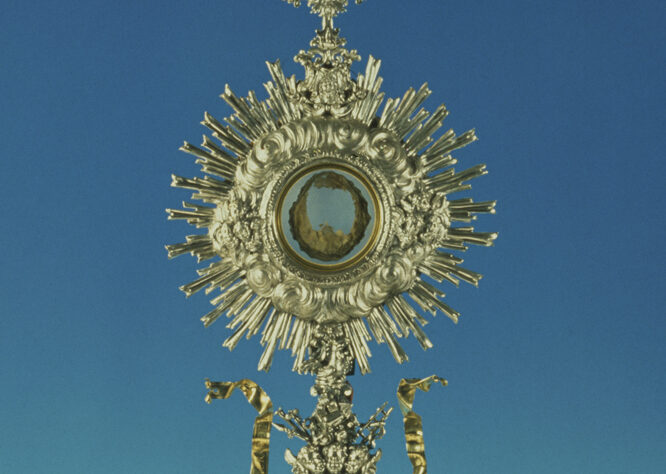The word “revive” literally means “to bring back to life.” That is the U.S. Bishops’ goal for the three-year Eucharistic Revival they launched this past summer on the feast of Corpus Christi. They hope to reawaken, to revive in us, an intimate experience of Jesus in the Eucharist.
Consider another word with the same root as revive: “vivid.” When we speak of having a vivid dream or a vivid memory, we mean we have experienced it with intense sharpness and clarity; we mean it has come alive for us. This helps drive home the same point the bishops hope to nourish in us—a more vivid, intense, enlivened awareness that it is truly Jesus whom we receive onto our tongues and into our hearts at Mass. It is truly Jesus whom we adore in Eucharistic exposition upon the altar, or enclosed in the tabernacle.
Why do we need this Eucharistic Revival? We need it because it is not easy for us to sustain an unshakeable belief in Jesus’ Real Presence in the Eucharist. It requires an act of faith that takes us beyond our senses of sight and taste, which are unable to detect the transformation of bread and wine into the Body and Blood of Jesus. And when we receive holy Communion week after week, year after year, the sheer force of habit can numb us to the glorious reality of that transformation.
God sees our weakness, of course. So He has done something about it. He has lavished His Church with an abundance of Eucharistic miracles. These have been incorporated into a Vatican International Exhibit of 126 documented Eucharistic miracles, which have occurred over the centuries and around the world. Parishes in the Diocese of La Crosse will have access to this exhibit during the Eucharistic Revival, as explained on the website diolc.org/eucharist. The displays in the exhibit can also be viewed by visiting miracolieucaristici.org, where the illustrated accounts can be accessed in English and many other languages. The very first one in the alphabetical listing is not to be missed. It occurred in Buenos Aires, Argentina in the 1990s, when Pope Francis was the Archbishop, and its details are stunning.
My Encounter with a Eucharistic Miracle
I can testify to the impact a Eucharistic miracle can have. Studying in Rome in the 1980s, I had the opportunity to make a pilgrimage to the site of the first and most famous Eucharistic miracle, the miracle of Lanciano. It occurred in about 750 A.D., when a Basilian priest was celebrating Mass at the monastery church of St. Longinus. He was struggling with doubts about Christ’s Real Presence in the Eucharist when, at the words of Consecration, the host in his hands became visible flesh and the consecrated wine became visible blood.
The monk was awestruck. Weeping joyously, he summoned the congregation to the altar to behold what he was seeing. The news spread throughout the surrounding area. The relics of the miracle were approved by the bishop and came to be preserved by the Basilian fathers, and later the Benedictines. They are still on display at the Church of St. Francis in Lanciano. After more than 1,200 years, the flesh, in the shape of a Communion host, and the dried globules of blood from the chalice, are still miraculously intact.
In 1971, Pope Paul VI permitted a series of scientific analyses, with stunning findings: the flesh was real human flesh, a thin cross-section from the heart. The blood was true human blood, of type AB (the rarest type), the same type found on the Shroud of Turin, and inexplicably it had the characteristics of freshly drawn, “living” blood—after 1,200 years! In 1973, the World Health Organization (WHO) appointed a scientific commission to verify these and many other results from the original study. The work was carried out over 15 months with a total of 500 examinations, and all the original conclusions were confirmed. How providential of God to put this miracle in a “time capsule” that could only be fully opened with the scientific advances of the 20th century (a feature of other Eucharistic miracles as well).
From a Belief of the Mind
to a Fire in the Heart
Our group of pilgrims at Lanciano was invited up to the altar to see the reliquaries containing the host of dried flesh and the globules of dried blood. Beholding them with my own eyes and reading the historical details and scientific findings, I was overcome with a sense of awe and gratitude. Yes, in faith I already believed in the Real Presence of Jesus in the Eucharist. But confronted with this miracle of God’s love, that belief of my mind became a fire in my heart, vivid and alive. The memory of it stirs me still, and I am so grateful to God for giving us this help along the way.
As we continue our Lenten journey in this time of Eucharistic Revival, let us take the opportunity to explore these miracles. Jesus has given them to us to inflame our hearts and reawaken our sense of wonder. May our encounter be alive and vivid as we go to meet Him, truly present, in the Sacrament of His Body and Blood.
Chris Ruff
Director of the Office for Ministries and Social Concerns
Published in the March/April 2023 issue of Catholic Life Magazine


